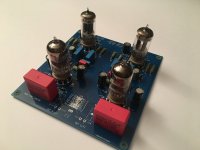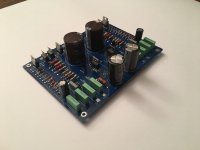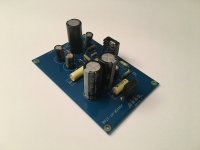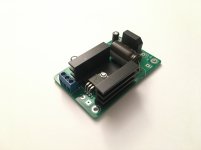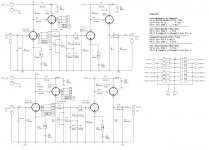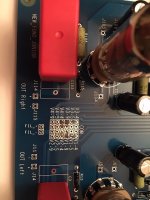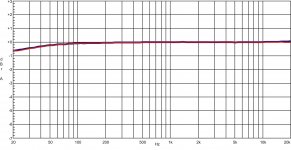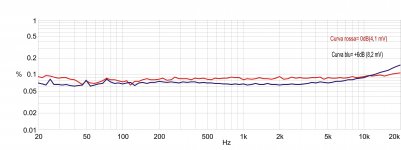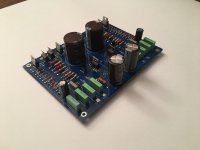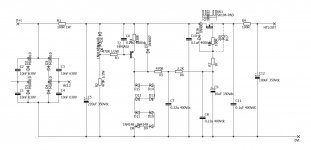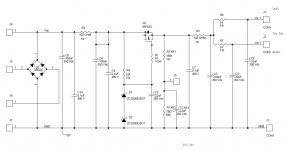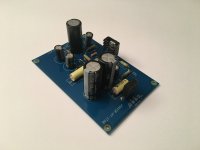Hello,
with the nr. 418 of Audioreview in Italy I have presented a phono tube circuit with the pcb.
In photo the boards completely mounted.
It is a passive riaa.
In the second photo there is a board for HT regulated with fet; it is dual mono.
In addition there is an other HT regulated but with a single Fet. This is a less complicate otpion.
Last photo is a pcb for supply for filament with a LM350T.
Walter
with the nr. 418 of Audioreview in Italy I have presented a phono tube circuit with the pcb.
In photo the boards completely mounted.
It is a passive riaa.
In the second photo there is a board for HT regulated with fet; it is dual mono.
In addition there is an other HT regulated but with a single Fet. This is a less complicate otpion.
Last photo is a pcb for supply for filament with a LM350T.
Walter
Attachments
In attach the circuit.
Each gain stage has a CF.
Two gain stage, in the middle the riaa circuit.
The board ( on the right side there is a legend, in italian) has the filament configurable to use the 12xxx or 6DJ8/6N6/PCC88/6H30/6922/ECC88 simply connecting few jumpers.
In the photo the details of the matrix.
Each gain stage has a CF.
Two gain stage, in the middle the riaa circuit.
The board ( on the right side there is a legend, in italian) has the filament configurable to use the 12xxx or 6DJ8/6N6/PCC88/6H30/6922/ECC88 simply connecting few jumpers.
In the photo the details of the matrix.
Attachments
Some test lab.
First test is a response freq. with a ECC83 as first tube, 4,1 mV for 550mV out, gain 41,7 dB.
It is possible simply adding the cap on each cathode of the tube on gain stage to increas the gain until 48 dB.
The CF tubes in this case are PCC88.
There in no change on response as the test says, there are two curves, one without caps and the other with caps, they are perfectly equal.
The curve is very good, there is a loss of 0,6 dB at 20Hz
The other test is the THD vs Freq at 4,1mV and 8,2 mv (+ 6dB)
It is a good prefromance.
In this circuit I have tested other tubes and in the next Audioreview I will show the results, they are very interesting.
The overload with ECC83, 41,7 dB of gain, is 70mV at 1 khz with 1% of THD and the output is 8,5 volt.
The Zout is around 250 ohm
In the next future I suppose I will have all pcb set ready
First test is a response freq. with a ECC83 as first tube, 4,1 mV for 550mV out, gain 41,7 dB.
It is possible simply adding the cap on each cathode of the tube on gain stage to increas the gain until 48 dB.
The CF tubes in this case are PCC88.
There in no change on response as the test says, there are two curves, one without caps and the other with caps, they are perfectly equal.
The curve is very good, there is a loss of 0,6 dB at 20Hz
The other test is the THD vs Freq at 4,1mV and 8,2 mv (+ 6dB)
It is a good prefromance.
In this circuit I have tested other tubes and in the next Audioreview I will show the results, they are very interesting.
The overload with ECC83, 41,7 dB of gain, is 70mV at 1 khz with 1% of THD and the output is 8,5 volt.
The Zout is around 250 ohm
In the next future I suppose I will have all pcb set ready
Attachments
With the 83 I got -78 dB weighted "A" with 41,7 db of gain
With 5965 is better, around -81 dB
With 6072 around -80 dB
With 81 I will check (with other types)
Walter
With 5965 is better, around -81 dB
With 6072 around -80 dB
With 81 I will check (with other types)
Walter
Last edited:
I got -78 dB weighted "A"
What is your reference ?
Do you have any noise voltage readings with input terminated/shorted ?
Listen, I use the standard procedure that Audioreview is using
And the resuts are published and are ripetitive; in some case I got a better results with differente brand of same type ( but also same tube, same brand), as you know you can get few dB of difference.
For MM stage, 5mV in input then short the input with 600 ohm and read the output.
With 5 mV in this phono I have 610 mV out (41,7 dB of gain)
-78 dB are 7.943 times less than 610 mV = 0,07 mv ( residual in ouput)
0,07 mV divided by 122 = 0,5 uV this is the noise voltage reffered to the input.
For a 83 is not bad.
This was done with AP One and AP Two for check
note: for MC stage the input voltage is 0,5 mV as standard and the measurement on output (no signal) is done with the input shorted.
Walter
And the resuts are published and are ripetitive; in some case I got a better results with differente brand of same type ( but also same tube, same brand), as you know you can get few dB of difference.
For MM stage, 5mV in input then short the input with 600 ohm and read the output.
With 5 mV in this phono I have 610 mV out (41,7 dB of gain)
-78 dB are 7.943 times less than 610 mV = 0,07 mv ( residual in ouput)
0,07 mV divided by 122 = 0,5 uV this is the noise voltage reffered to the input.
For a 83 is not bad.
This was done with AP One and AP Two for check
note: for MC stage the input voltage is 0,5 mV as standard and the measurement on output (no signal) is done with the input shorted.
Walter
Last edited:
What power supply voltage is this amplifier using?
Cannot see this when looking at the circuit diagram, sorry.
Cannot see this when looking at the circuit diagram, sorry.
Nominal is 220 vdc
But it can works form 200 to 240 vdc
I will attach the power schematic
Walter
Can't you downscale it to 150V DC?
I use the standard procedure that Audioreview is using...
I have built and compared two basic passive RIAA amplifiers.
Unfortunately my noise measurements were done with different weighting and therefore I can not directly compare your results to mine.
However, my results show that high gm-triode 6S3P-EV has 6.6 dB lower noise level that 6N2P-EV, which is practically similar to ECC83.
to Joe
It is possible using the ECC88 ( but I will to check)
You can configure the filaments to have the first stage configured for 88 with some adjustement of resistors; the total gain of the stage will be about 32-35 dB maybe
to Artosalo
It is evident that with tubes with a low Rp (= higher gm normally) you can get a better s/n
With another circuit I use I reach -86dB with 42 dB of gain !
That it is great.
The fact is that with 83 this results is good due ( also) a good quality of the supply.
Walter
It is possible using the ECC88 ( but I will to check)
You can configure the filaments to have the first stage configured for 88 with some adjustement of resistors; the total gain of the stage will be about 32-35 dB maybe
to Artosalo
It is evident that with tubes with a low Rp (= higher gm normally) you can get a better s/n
With another circuit I use I reach -86dB with 42 dB of gain !
That it is great.
The fact is that with 83 this results is good due ( also) a good quality of the supply.
Walter
In attach the schematic of the two version of the regulated power supply.
For the dual mono one channel is shown.
The ac in input is 200 volt
For the dc the range is 200-240 vdc. Nominal 220-215 vdc
Walter
For the dual mono one channel is shown.
The ac in input is 200 volt
For the dc the range is 200-240 vdc. Nominal 220-215 vdc
Walter
Attachments
- Home
- Amplifiers
- Tubes / Valves
- Junior phono
